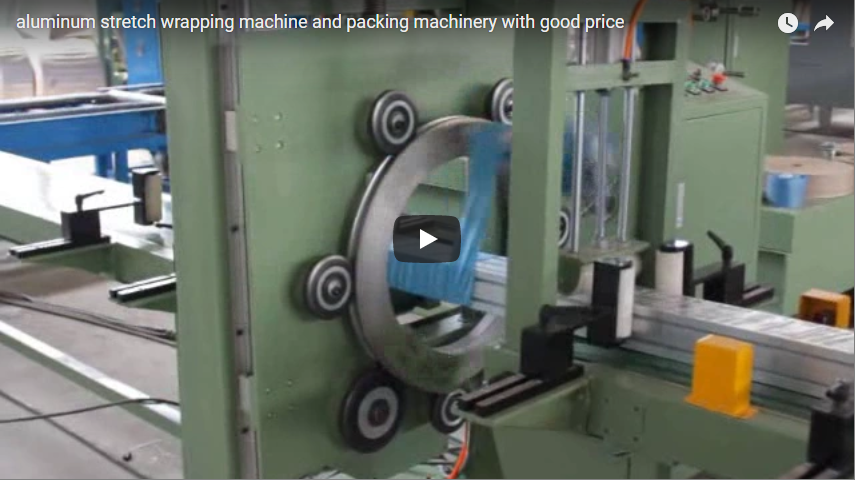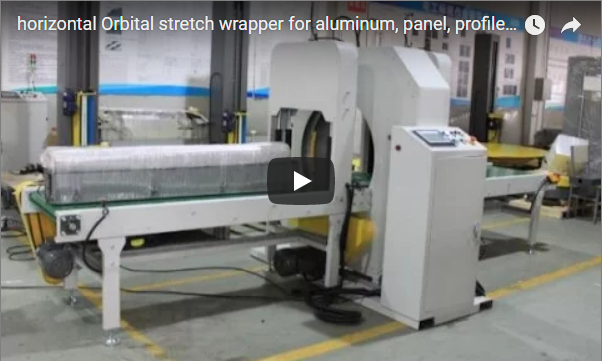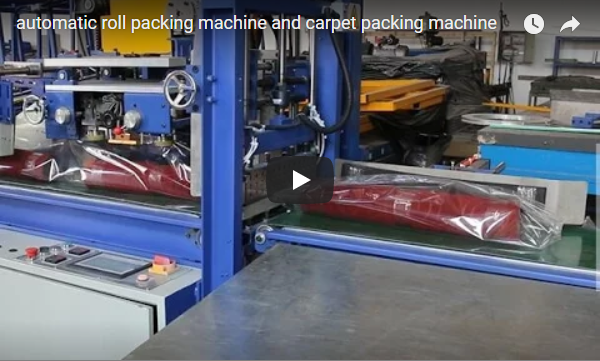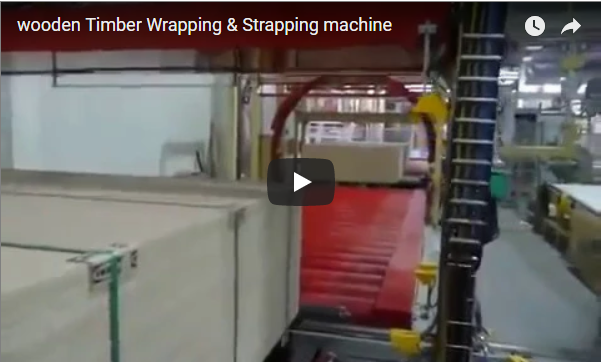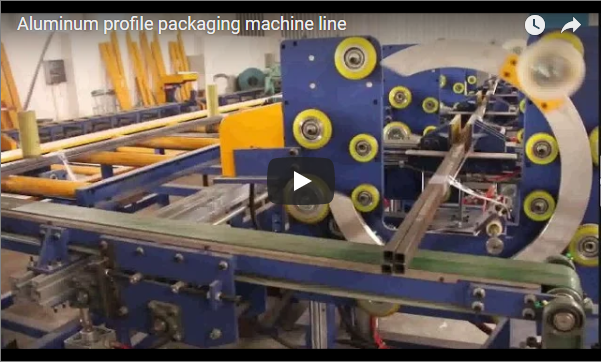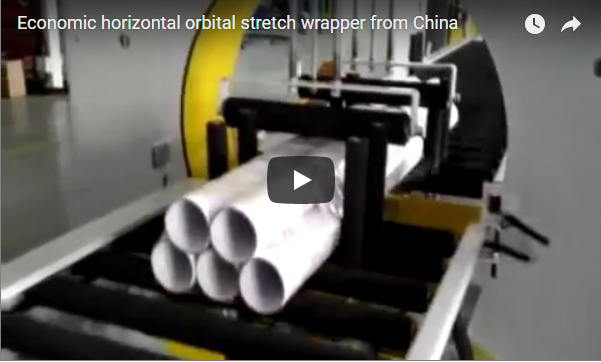In modern manufacturing and distribution, handling products of varying lengths efficiently poses a significant packaging challenge. Standard wrapping solutions often require adjustments or separate lines, leading to downtime and increased operational costs. The horizontal wrapping machine equipped with a transitional conveyor system emerges as a versatile and effective solution. This article explores the design, technical specifications, operational benefits, and applications of this specialized industrial packaging equipment.
Watch this machine in action:
1. Understanding the Horizontal Wrapping Machine with Transitional Conveyor
A horizontal wrapping machine, often referred to as an orbital wrapper, is designed to apply stretch film around elongated products as they pass horizontally through a rotating ring carrying the film roll. The key innovation in the model discussed here is the transitional conveyor belt. This feature allows the machine to automatically adapt to or seamlessly handle both long and short products without manual intervention or significant changeover time, making it ideal for facilities processing diverse product dimensions.
Unlike standard horizontal wrappers that might struggle with inconsistent lengths or require batch processing, this integrated system provides continuous flow capabilities for mixed-length items typically found in:
- Manufacturing facilities
- High-volume warehouses
- Logistics and distribution centers
2. Core Design and Structural Components
The effectiveness of this machine lies in its robust design and the synergy between its core components:
- Heavy-Duty Frame: Constructed typically from welded steel for stability and longevity in demanding industrial environments.
- Rotating Ring Assembly: Houses the film carriage and rotates around the product. Ring diameters vary based on the maximum product cross-section required. Drive mechanisms are usually belt-driven or gear-driven for smooth, high-speed operation.
- Film Carriage System: Features adjustable pre-stretch capabilities (often up to 250-300%) to maximize film yield and ensure load stability. Tension control is crucial and can be mechanical or electronic. Advanced systems include automatic film cutting and clamping units.
- Transitional Conveyor System: This is the differentiating element. It may consist of:
- Segmented Belts/Rollers: Sections that can activate or deactivate based on product length detected by sensors.
- Variable Speed Drives (VSDs): Allowing different conveyor sections to synchronize or adjust speeds for optimal product transfer and wrapping.
- Adjustable Height/Width Guides: To center and support products of varying dimensions.
The primary function is to provide consistent support and smooth passage for both short items (which might tip or get lost on standard conveyors) and long items, ensuring they are correctly positioned relative to the wrapping ring.
- Control System (PLC): Typically utilizes a Programmable Logic Controller (PLC) with a Human-Machine Interface (HMI) touchscreen for easy operation, parameter adjustment (e.g., wrap counts, overlap, tension), diagnostics, and recipe storage for different product types.
- Safety Features: Includes safety guarding, light curtains at entry/exit points, and emergency stop buttons compliant with industry safety standards.
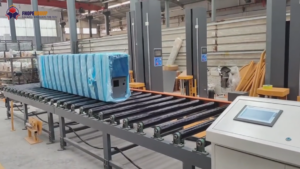
board and cabinet horizontal wrapping machine testing video with two layers packing material 3. Key Technical Specifications and Data Comparison
While exact specifications vary by manufacturer and model, typical performance parameters include:
- Product Handling Capabilities:
- Max. Product Cross-Section (W x H): Ranges from 400x400 mm to over 2000x2000 mm.
- Product Length: Highly variable due to the transitional conveyor; minimum lengths can be as short as 500mm, while maximum lengths are often limited only by factory layout (e.g., 6000mm, 12000mm, or longer).
- Performance Metrics:
- Ring Speed: Typically 30 - 90 RPM (Revolutions Per Minute), impacting throughput.
- Conveyor Speed: Adjustable, often ranging from 5 - 20 meters per minute.
- Wrapping Efficiency: Dependent on product length, ring speed, and desired film overlap.
- Wrapping Material:
- Film Type: Standard Stretch Film (LLDPE).
- Film Width: Commonly 125mm, 250mm, or 500mm.
- Film Thickness: Typically 17 - 35 microns.
- System Requirements:
- Power Supply: 3-phase, voltage specific to region (e.g., 480V/60Hz, 380V/50Hz).
- Compressed Air: Often required for film clamping/cutting units (e.g., 6-8 bar).
- Feature Comparison (Standard vs. Transitional Conveyor Wrapper):
| Feature | Standard Horizontal Wrapper | Transitional Conveyor Wrapper |
|---|---|---|
| Length Handling | Optimized for specific range | Wide range (Short & Long) |
| Changeover Time | May require for length change | Minimal to none for length change |
| Conveyor Design | Typically uniform rollers/belt | Adaptive/Segmented/Variable Speed |
| Product Stability | Can be challenging for shorts | Improved stability for all lengths |
| Operational Cost | Potentially higher (downtime) | Lower TCO due to flexibility |
| Footprint | Standard | May be slightly larger |
4. Operational Advantages and Efficiency Gains
Investing in a horizontal wrapper with a transitional conveyor yields significant benefits:
- Unmatched Versatility: Seamlessly wrap products of vastly different lengths on a single machine, eliminating the need for multiple specialized wrappers or complex manual adjustments.
- Increased Throughput: Minimizes downtime associated with equipment changeovers, leading to higher overall packaging line efficiency, especially in mixed-product environments.
- Reduced Labor Costs: Automation of the wrapping process for diverse products reduces manual handling requirements.
- Optimized Material Usage: Precise control over film tension and pre-stretch ensures efficient film consumption and consistent load containment.
- Enhanced Product Protection: Provides a secure, tight wrap that protects products from dust, moisture, scratches, and shifting during transit and storage.
- Improved Workplace Safety: Reduces manual lifting and handling of long or awkward items, minimizing risks of worker injury.
5. Applications Across Industries
The flexibility of this machine makes it suitable for a wide range of industries and products:
- Building Materials: Lumber, timber beams, PVC pipes, conduits, insulation panels, aluminum profiles, steel bars.
- Furniture Manufacturing: Table legs, components, flat-packed furniture elements.
- Textiles: Fabric rolls, carpets.
- Automotive: Exhaust pipes, trim components, longer spare parts.
- Doors and Windows: Frames, panels, assembled units.
- General Manufacturing: Any elongated items requiring protective wrapping.
6. Integrating with Existing Production Lines
These machines are designed for integration into automated production lines. They can be placed downstream from extrusion, sawing, or assembly processes and upstream from palletizing or shipping areas. Communication protocols often allow them to interface with SCADA or MES systems for centralized control and monitoring. Infeed and outfeed conveyor systems can be customized to match existing line heights and configurations.
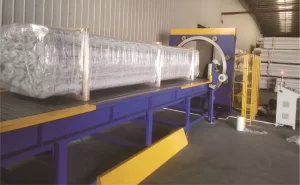
7. User Experience and Maintenance Considerations
Modern machines prioritize ease of use:
- Intuitive HMI: Touchscreen interfaces simplify operation, recipe selection, and troubleshooting.
- Easy Film Loading: Quick-load film carriages minimize downtime for roll changes.
- Low Maintenance: Designed with durable components, requiring standard preventive maintenance like lubrication, cleaning, and inspection of wear parts (belts, rollers, cutting blades). Access points are generally designed for easy maintenance.
8. FHOPE Solution Spotlight
FHOPE is a notable manufacturer offering horizontal wrapping machines featuring transitional conveyor belts, often providing cost-effective solutions. Their machines are engineered for ease of use and can handle a diverse range of product lengths effectively. A key advantage offered by FHOPE is their capacity for customization, allowing them to tailor wrapping machine specifications—such as ring size, conveyor configuration, and control features—to meet precise customer requirements, ensuring an optimal fit for unique production needs.
Explore FHOPE's horizontal wrapping solutions here:
https://www.fhopepack.com/Horizontal_wrapping_machine.html
Conclusion
The horizontal wrapping machine with a transitional conveyor belt represents a significant advancement in packaging technology for businesses handling variable-length products. Its ability to combine the wrapping efficiency of orbital systems with the flexibility to manage diverse dimensions without interruption offers substantial gains in productivity, cost savings, and operational adaptability. For industries demanding both high throughput and versatility in their end-of-line packaging, this technology provides a robust and future-proof solution.

